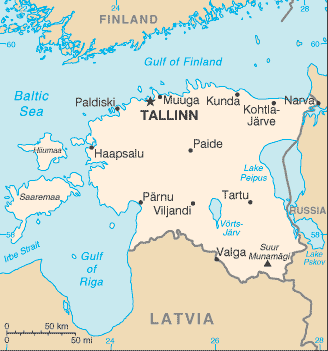|
Estonia
|

|
Capital: Tallinn
Population: 1,325,648
Brief History of Estonia:
Ancient Estonians lived on the shores of the Baltic Sea for thousands of years. They are one of the longest-settled peoples on the continent of Europe. They remained independent until the 1200s when they were conquered by many different empires including Denmark, Germany, Sweden, and Russia.
In modern times, Estonia was forced in the Soviet Union in 1940. With the collapse of the Soviet Union, it once gained its freedom and independence in 1991. Estonia has been a member of the European Union since 2004.
The Geography of Estonia
Total Size: 45,226 square km
Size Comparison: slightly smaller than New Hampshire and Vermont combined
Geographical Coordinates: 59 00 N, 26 00 E
World Region or Continent: Europe
General Terrain: marshy, lowlands; flat in the north, hilly in the south
Geographical Low Point: Baltic Sea 0 m
Geographical High Point: Suur Munamagi 318 m
Climate: maritime, wet, moderate winters, cool summers
Major cities: TALLINN (capital) 399,000 (2009), Tartu
The People of Estonia
Type of Government: parliamentary republic
Languages Spoken: Estonian (official) 67.3%, Russian 29.7%, other 2.3%, unknown 0.7% (2000 census)
Independence: 20 August 1991 (from Soviet Union)
National Holiday: Independence Day, 24 February (1918); note - 24 February 1918 is the date Estonia declared its independence from Soviet Russia; 20 August 1991 is the date it declared its independence from the Soviet Union
Nationality: Estonian(s)
Religions: Evangelical Lutheran 13.6%, Orthodox 12.8%, other Christian (including Methodist, Seventh-Day Adventist, Roman Catholic, Pentecostal) 1.4%, unaffiliated 34.1%, other and unspecified 32%, none 6.1% (2000 census)
National Symbol: barn swallow, cornflower
National Anthem or Song: Mu isamaa, mu onn ja room (My Native Land, My Pride and Joy)
Economy of Estonia
Major Industries: engineering, electronics, wood and wood products, textile; information technology, telecommunications
Agricultural Products: potatoes, vegetables; livestock and dairy products; fish
Natural Resources: oil shale, peat, phosphorite, clay, limestone, sand, dolomite, arable land, sea mud
Major Exports: machinery and equipment 33%, wood and paper 15%, textiles 14%, food products 8%, furniture 7%, metals, chemical products (2001)
Major Imports: machinery and equipment 33.5%, chemical products 11.6%, textiles 10.3%, foodstuffs 9.4%, transportation equipment 8.9% (2001)
Currency: Estonian kroon (EEK)
National GDP: $27,310,000,000
** Source for population (2012 est.) and GDP (2011 est.) is CIA World Factbook.
Back to Geography Home Page
